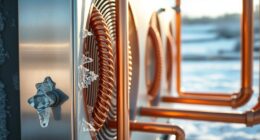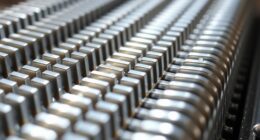We have exclusive tips on how to properly maintain the refrigeration cycle of heat pumps. Regular maintenance is essential to ensure optimal performance and avoid costly breakdowns.
In this article, we’ll reveal the signs of refrigeration cycle issues in a heat pump and guide you through the essential steps of cleaning, inspecting, lubricating, and adjusting the refrigeration components.
We’ll also share troubleshooting tips for common problems and expert advice for maintaining your heat pump’s refrigeration cycle.
Get ready to keep your heat pump running smoothly!

Key Takeaways
- Regular maintenance is essential for identifying and addressing potential issues in the heat pump refrigeration cycle.
- Proactive maintenance helps save costs on repairs and prevents downtime.
- Regular maintenance ensures peak efficiency and energy savings in the system.
- Signs of refrigeration cycle issues, such as inadequate cooling or heating, increased energy consumption, unusual noises, and refrigerant leaks, should be promptly addressed by a professional technician.
Understanding the Heat Pump Refrigeration Cycle
First, let’s take a look at the basic principles behind the heat pump refrigeration cycle. The heat pump refrigeration cycle operates on the principle of transferring heat from a low-temperature source to a high-temperature sink, using a working fluid.
The cycle consists of four main components: the compressor, condenser, expansion valve, and evaporator. The compressor plays a crucial role in raising the temperature and pressure of the refrigerant, while the condenser releases heat to the surroundings. The expansion valve controls the flow of the refrigerant, reducing its pressure and temperature. Lastly, the evaporator absorbs heat from the surroundings, allowing the refrigerant to evaporate.
Troubleshooting refrigeration cycle problems involves checking for issues such as insufficient refrigerant charge, faulty components, or improper airflow. Understanding the heat pump refrigeration cycle operation is vital for effective troubleshooting and maintenance.
With this knowledge, we can now delve into the importance of regular maintenance for the refrigeration cycle.
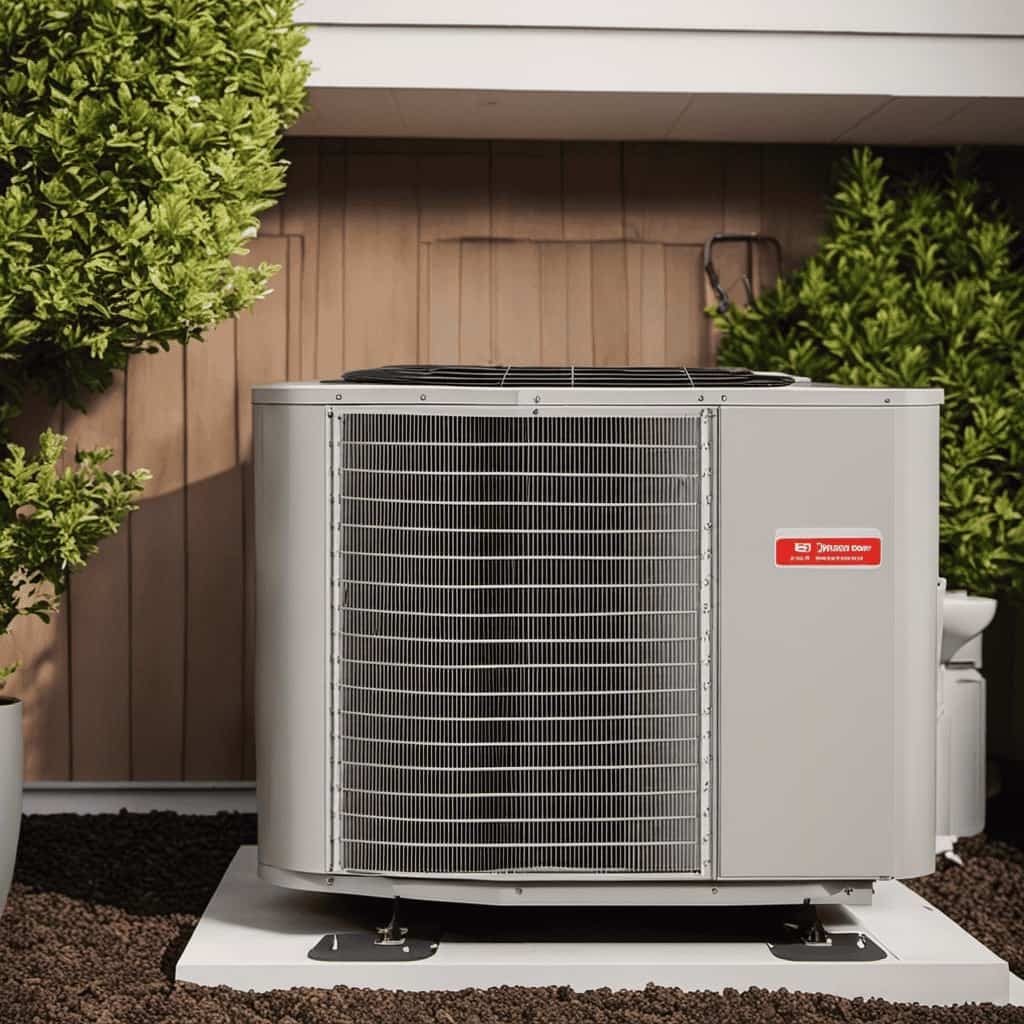
Importance of Regular Maintenance for the Refrigeration Cycle
Regular maintenance is essential for ensuring the optimal performance and longevity of the refrigeration cycle. By conducting regular maintenance, you can reap numerous benefits for your heat pump’s refrigeration cycle. Firstly, regular maintenance helps to identify and address any potential issues before they escalate into major problems. This proactive approach can save you from costly repairs and downtime.
Additionally, regular maintenance ensures that the refrigeration cycle operates at peak efficiency, which can lead to energy savings and lower utility bills. The frequency of refrigeration cycle maintenance depends on various factors such as the usage patterns, environmental conditions, and manufacturer recommendations. Typically, it’s recommended to have the refrigeration cycle inspected and serviced at least once a year.
By adhering to a regular maintenance schedule, you can maximize the performance and lifespan of your heat pump’s refrigeration cycle.
Now, let’s move on to discussing the signs of refrigeration cycle issues in a heat pump.
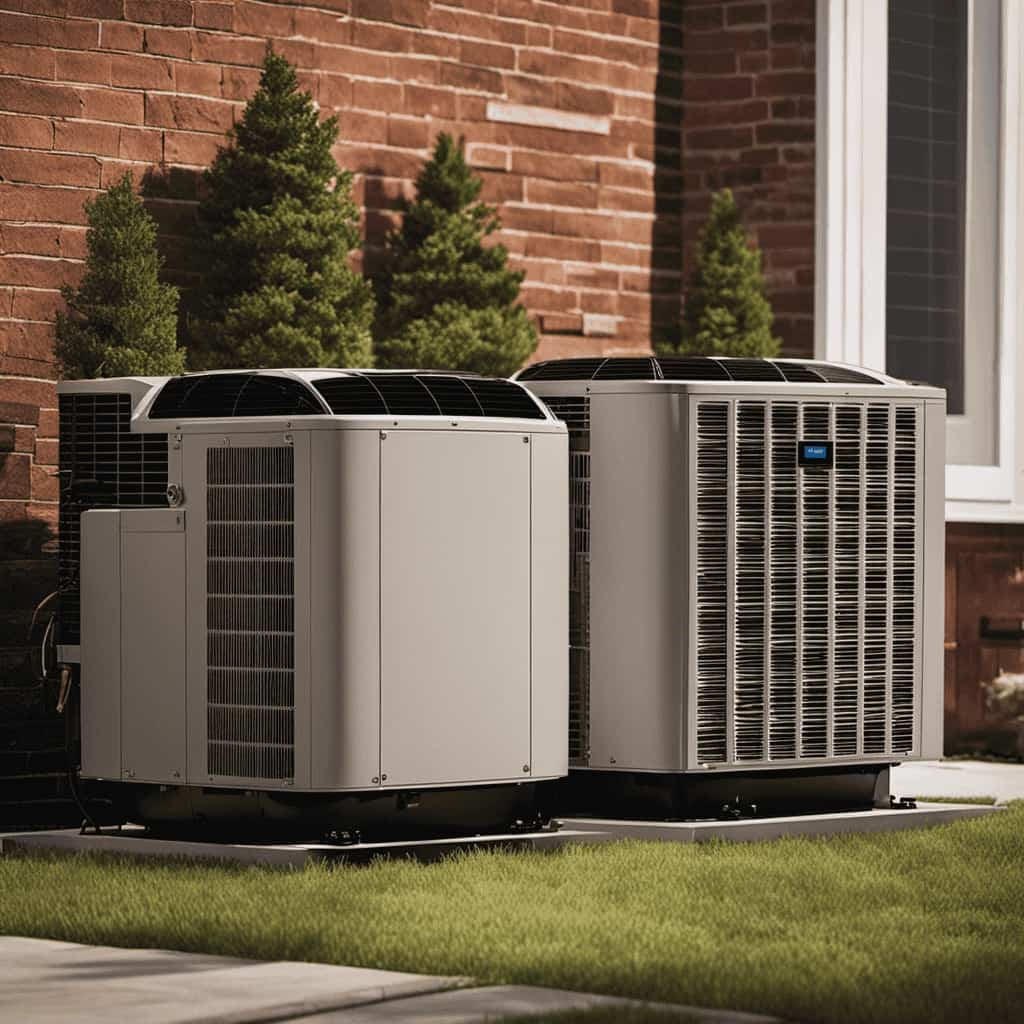
Signs of Refrigeration Cycle Issues in a Heat Pump
When identifying potential refrigeration cycle issues in a heat pump, it’s important to be aware of certain signs that may indicate a problem. Common signs of refrigeration cycle issues include:
- Inadequate cooling or heating
- Increased energy consumption
- Unusual noises
- Refrigerant leaks
If you notice that your heat pump isn’t providing the desired cooling or heating, it could be a sign of a refrigeration cycle issue. Additionally, an increase in energy consumption without any apparent reason may indicate an inefficient refrigeration cycle. Unusual noises such as grinding, banging, or squealing could be a result of a malfunctioning component within the refrigeration cycle. Finally, if you notice refrigerant leaks, it’s crucial to address the issue promptly as it can lead to further damage.
To troubleshoot these issues, it’s recommended to consult a professional technician who can diagnose and repair the problem accurately.
Cleaning and Inspecting the Refrigeration Components
When it comes to maintaining the refrigeration components of a heat pump, there are a few key points to keep in mind. Regular cleaning and inspection of these components is crucial in preventing failures in the refrigeration system.

Maintenance Tips for Components
To properly maintain our heat pump refrigeration cycle, we need to regularly clean and inspect the various refrigeration components. This ensures optimal performance and prolongs the lifespan of the system.
When it comes to cleaning, it’s important to use appropriate tools and techniques. Dust, debris, and dirt can accumulate on the evaporator and condenser coils, reducing their efficiency. Regularly cleaning these coils with a soft brush or vacuum can prevent this buildup.
Additionally, inspecting the refrigerant lines for leaks is crucial. Any signs of oil or refrigerant around the connections should be addressed immediately.
Furthermore, checking the fan motor and blades for any obstructions is essential to maintain proper airflow.
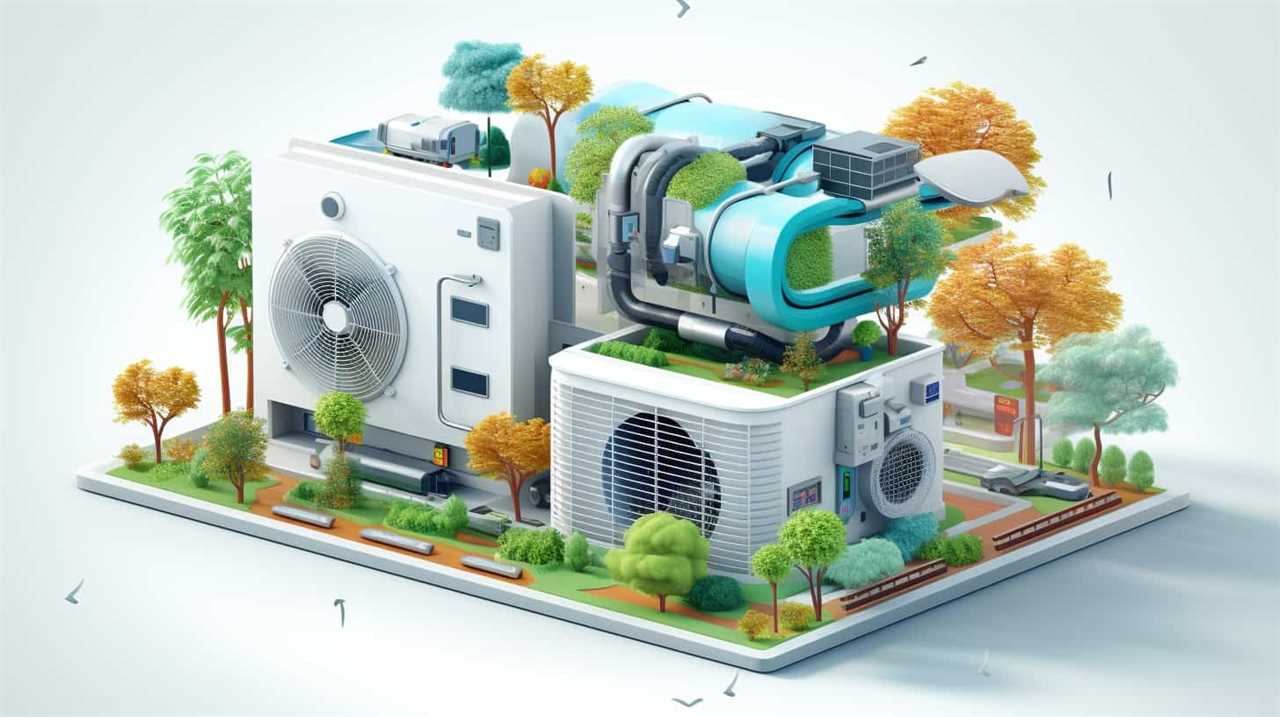
Preventing Refrigeration System Failures
We regularly clean and inspect the refrigeration components to prevent system failures. By maintaining a clean and well-maintained refrigeration system, we can prevent system malfunctions and extend its lifespan.
One important aspect of preventing system failures is cleaning the condenser coils. Over time, these coils can become clogged with dirt, dust, and debris, reducing their efficiency and causing the system to work harder. Regularly cleaning the condenser coils ensures proper heat transfer and prevents overheating, which can lead to system breakdowns.
Additionally, we inspect the refrigerant lines for any leaks or damage. Leaks can cause a loss of refrigerant, reducing the system’s cooling capacity and potentially damaging other components. By identifying and repairing any leaks early on, we can prevent further damage and ensure optimal system performance.
Lubricating and Adjusting the Refrigeration Cycle Components
Our team regularly lubricates and adjusts the refrigeration cycle components to ensure optimal performance. Proper lubrication is essential for maintaining the efficiency of the refrigeration cycle. We use high-quality lubricants that are specifically designed for heat pump systems. These lubricants reduce friction and wear, preventing premature component failure and ensuring smooth operation.

In addition to lubrication, we also regularly adjust the refrigeration cycle components to optimize their performance. This involves checking and adjusting the refrigerant charge, ensuring proper airflow across the evaporator and condenser coils, and calibrating the expansion valve. These adjustments help to maintain the refrigeration cycle efficiency and prevent potential issues such as insufficient cooling or heating.
When troubleshooting the refrigeration cycle, we follow a systematic approach. We start by inspecting the components for any signs of damage or wear. We also check for refrigerant leaks and measure the temperature and pressure at various points in the cycle. By identifying and addressing any issues promptly, we can ensure that the system operates at its best and provide reliable cooling and heating for our customers.
Troubleshooting Common Refrigeration Cycle Problems
When troubleshooting common refrigeration cycle problems, we identify the root cause and implement appropriate solutions. Here are three common issues that can arise in the refrigeration cycle and how to address them:
- Troubleshooting compressor issues:
- Check for proper power supply and voltage.
- Inspect the compressor for any physical damage or oil leaks.
- Test the compressor motor windings and capacitors for faults.
- Identifying refrigerant leaks:
- Inspect all connections and fittings for signs of leakage.
- Use a leak detection tool to pinpoint the exact location of the leak.
- Repair the leak and recharge the system with the correct amount of refrigerant.
By addressing these common problems promptly, you can ensure the optimal performance of the heat pump refrigeration cycle.
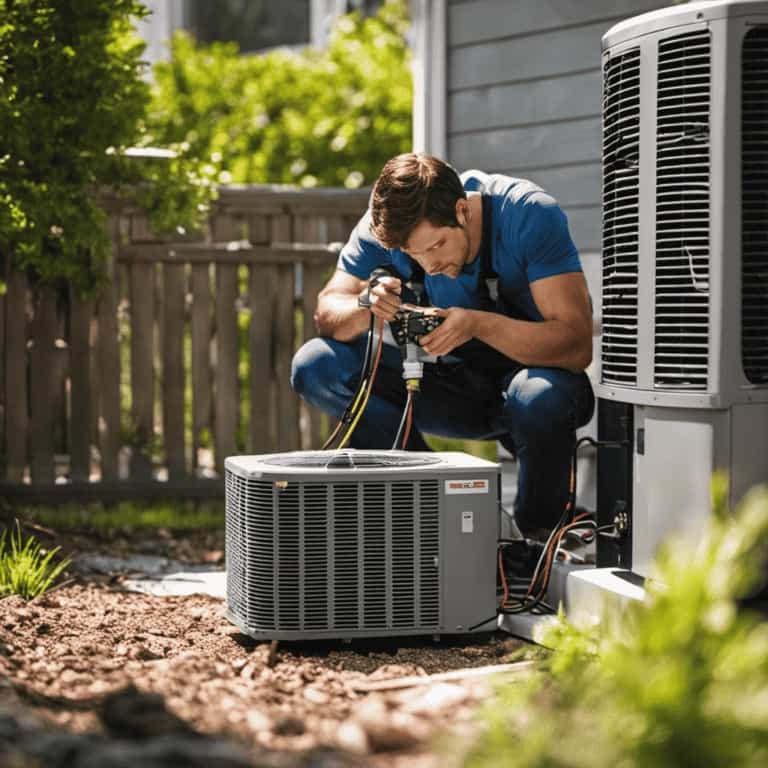
Now, let’s move on to the next section where we’ll discuss professional maintenance tips for the heat pump refrigeration cycle.
Professional Maintenance Tips for the Heat Pump Refrigeration Cycle
Regular maintenance is crucial for ensuring the optimal performance of the heat pump refrigeration cycle. In this section, we’ll discuss some professional maintenance tips that can help address common issues and provide effective solutions.
Additionally, we’ll explore some do-it-yourself techniques that can be employed to maintain the heat pump refrigeration cycle in top condition.
Importance of Regular Maintenance
We find that consistent maintenance is crucial for ensuring the optimal performance and longevity of the heat pump refrigeration cycle. Regular servicing provides several benefits of preventative maintenance, such as:
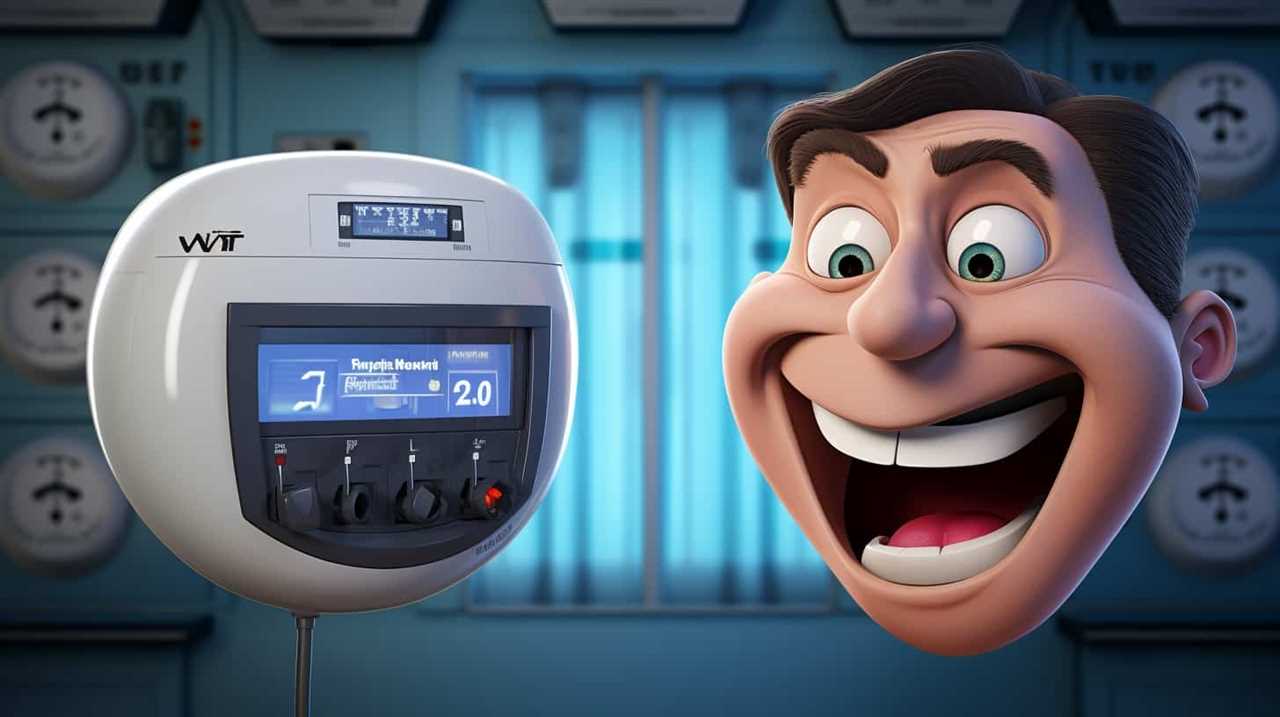
-
Enhanced Efficiency: Regular maintenance helps to keep the heat pump refrigeration cycle operating at its highest efficiency, resulting in energy savings and lower utility bills.
-
Extended Lifespan: By addressing potential issues early on, regular maintenance can help to prevent major breakdowns and extend the lifespan of the heat pump refrigeration cycle.
-
Improved Air Quality: Proper maintenance includes cleaning and changing filters, which helps to maintain clean and healthy indoor air quality.
By prioritizing regular maintenance, you can ensure that your heat pump refrigeration cycle operates smoothly and efficiently, minimizing the chances of encountering common issues and the need for costly repairs.

Let’s now delve into some common issues and their solutions.
Common Issues and Solutions
Let’s address some common issues and provide solutions for the heat pump refrigeration cycle during professional maintenance.
One common issue that may arise is insufficient cooling or heating. This can be caused by a dirty or clogged air filter, which restricts airflow. Cleaning or replacing the air filter can solve this problem.
Another common issue is a refrigerant leak. This can be detected by low refrigerant levels or reduced cooling or heating capacity. To fix this issue, the leak must be located and repaired, and the refrigerant levels must be properly restored.
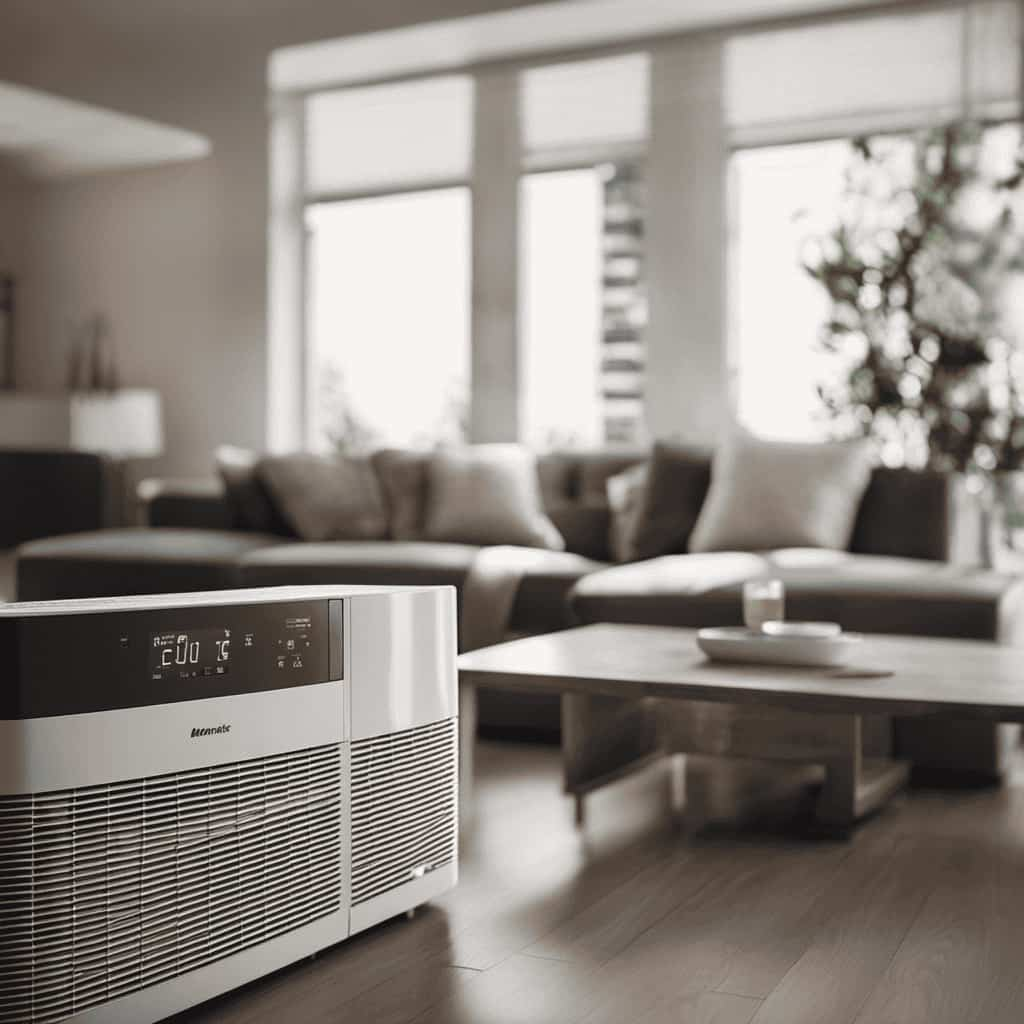
Additionally, inadequate lubrication of the compressor can lead to compressor failure. Regular lubrication checks and maintenance can prevent this issue.
DIY Maintenance Techniques
Our professional maintenance tips for the heat pump refrigeration cycle will help you effectively perform DIY maintenance techniques. By following these cost-effective maintenance techniques, you can ensure the optimal performance and longevity of your heat pump refrigeration cycle.
Here are three DIY maintenance techniques that you can implement using common DIY maintenance tools:
-
Regularly clean the heat pump coils: Over time, dust and debris can accumulate on the coils, reducing the efficiency of the heat pump. Using a soft brush or a vacuum cleaner with a brush attachment, gently remove any dirt or debris from the coils.

-
Check and replace air filters: Clogged air filters can restrict airflow and put strain on the heat pump. Regularly inspect the air filters and replace them if they’re dirty or damaged. This simple step can improve the performance and energy efficiency of your heat pump.
-
Keep the outdoor unit free from obstructions: Ensure that the outdoor unit is clear from any vegetation, leaves, or debris. Obstructions can restrict airflow and reduce the heat pump’s efficiency. Regularly trim any nearby vegetation and remove any debris to maintain proper airflow.
Frequently Asked Questions
How Often Should the Refrigeration Cycle in a Heat Pump Be Inspected and Cleaned?
We should regularly inspect and clean the refrigeration cycle in our heat pump to ensure its optimal performance. DIY heat pump maintenance includes checking for any dirt or debris that may obstruct the system and cleaning or replacing filters as necessary.
Can a Homeowner Perform Maintenance on the Refrigeration Cycle Components Themselves, or Is It Necessary to Hire a Professional?
A homeowner can perform maintenance on the refrigeration cycle components themselves, but it is recommended to hire a professional for optimal results. Professional expertise ensures proper inspection and cleaning, maximizing the heat pump’s efficiency and longevity.

What Are the Potential Consequences of Neglecting Regular Maintenance for the Refrigeration Cycle?
Neglecting regular maintenance of the refrigeration cycle can lead to disastrous consequences. Components may fail, efficiency may decrease, and energy bills may skyrocket. Don’t underestimate the importance of proper maintenance.
Are There Any Specific Signs or Symptoms That Indicate a Refrigeration Cycle Issue in a Heat Pump?
Signs and symptoms of a refrigeration cycle issue in a heat pump may include reduced cooling or heating performance, strange noises, or increased energy consumption. Regular refrigeration cycle maintenance and heat pump inspections can help identify and address these issues.
Is It Possible to Over-Lubricate or Over-Adjust the Refrigeration Cycle Components, and What Are the Potential Risks if This Occurs?
Over-lubricating or over-adjusting refrigeration cycle components can lead to potential risks. It is important to maintain a proper balance to prevent damage and ensure optimal performance.
Conclusion
In conclusion, regular maintenance is essential for the efficient operation of the heat pump refrigeration cycle.

By cleaning, inspecting, lubricating, and adjusting the refrigeration components, potential issues can be identified and resolved before they escalate.
Troubleshooting common problems and seeking professional maintenance tips can further enhance the performance and longevity of the heat pump.
Remember, a well-maintained refrigeration cycle is the key to keeping your heat pump running smoothly, like a finely tuned instrument in an orchestra.






